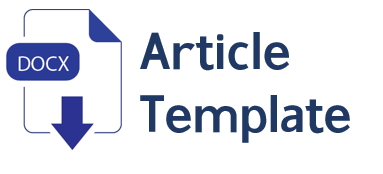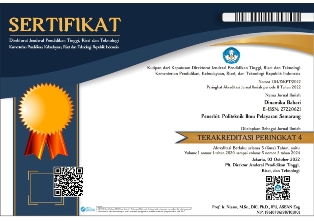The Student Officer's Understanding of Ballast Water Treatment According to The Ballast Water Management (BMW) Convention
Abstract
The ballast water used as a ship's stabilizer when it is not loaded has a negative impact on health and the environment and even causes economic losses. One of them is caused by the pathogenic microbes in it. Therefore, the International Maritime Organization (IMO) enacted the Ballast Water Management (BWM) Convention to prevent the spread of pathogenic microbes that are very dangerous to health and the environment. The purpose of this study is to find out the extent of understanding of BWM Convention of the Deck and Engine Officer Class I and II in PIP Semarang. An analytical description and an overlap approach, including questionnaires, and in-depth interviews were applied to the research method. A total of 27 students from the deck and engine departments were included in the sample. According to the survey's findings, most participants don't fully comprehend the BWM contract. When being asked whether BWM was regulated, the correct answer was 0%. The right response when being asked whether Indonesia ratified the BWM was 0%. When being asked how the efficiency of BWM was 3.7% for the D-1 standard (ballast replacement) and 11.1% for the D-2 standard (ballast handling). However, 44.4% of respondents correctly identified the significance of treating ballast water, indicating that they are worried about the threat posed by this substance and that immediate action is required. The idea is to provide the student officers with knowledge via seminars, which could include training on maritime pollution or special ballast water training.
Downloads
References
Altug, G., Gurun, S., Cardak, M., Ciftci, P. S., & Kalkan, S. (2012). The occurrence of pathogenic bacteria in some ships’ ballast water incoming from various marine regions to the Sea of Marmara, Turkey. Marine Environmental Research, Vol:81, Pg: 35–42. https://doi.org/10.1016/j.marenvres.2012.08.005
Ardura, A., Martinez, J.L., Zaiko, A., Garcia-Vazquez, E. (2021). Poorer diversity but tougher species in old ballast water: Biosecurity challenges explored from visual and molecular techniques. Mar Pollut Bull. 168: 112465. doi: 10.1016/j.marpolbul.2021.112465.
Dobbs, F.C., Goodrich, A. L., Thomson III, F. K., Hynes, W. (2013). Pandemic Serotypes of Vibrio cholerae Isolated from Ships’ Ballast Tanks and Coastal Waters: Assessment of Antibiotic Resistance and Virulence Genes (tcpA and ctxA). Microbiology of Aquatic Systems. Published: 30 January 2013.
El-Husna, I., S.Anggoro., H.R.Sunoko., Subagiyo. (2022). Bacteriological Study of Ballast Water at Tanjung Emas Port, Semarang. Indonesian Journal of Maritime Scences, March 2022. Vol 27 (1): 45-52
El-Husna,I. Anggoro,S. Sunoko,H.R. Setyani,O. (2017). Impact of Ballast Water on Environment Health. Advanced Science Letters, vol 4,1-3,2012, American Scientific Publishers
Erga, O.K.H., J.M. Andres, O. Enger, dan O. Vadstein. (2019). Microorganisms in ballast water: Disinfection, community dynamics, and implications for management. Science of The Total Environment. 657: 704-716. DOI: https://doi.org/10.1016/j.scitotenv.2018.12.004.
Fugazza, Marco., Hoffman, Jan. (2017). Liner Shipping conectivity as determinant of trade. Journal of Shipping and trade. Vol:2, No: 1. Published 02 March 2017.
Gollasch, S., David, M. (2018). Ballast water: problems and management. World Seas: an Environmental Evaluation .Vol: III: Ecological Issues and Environmental.
Elçiçek H., A. Parlak., M. Çakmakçı. (2013). Effect of Ballast Water on Marine and Coastal Ecology. Digital Proceeding Of The ICOEST 2013 - , Cappadocia C.Ozdemir, S. Şahinkaya, E. Kalıpcı, M.K. Oden (editors) Nevsehir, Turkey, June 18 – 21, 2013
IMO. (2009).Ballast Water Management Convention and the Guidlines for its implenetation, 2009 edition. London. ISBN: 978-92-801-1503-1
Lasabud, R. (2013). Pembangunan Wilayah Pesisir dan Lautan dalam Perspektif Negara Kepulauan Republik Indonesia (Regional Development in Coastal and Ocean in Archipelago Perspective of The Republic of Indonesia). Jurnal Ilmiah Platax , Vol. I-2, Januari 2013 ISSN: 2302-3589
Rivera, I. N. G., Souza, K. M. C., Souza, C. P., & Lopes, R. M. (2012). Free-living and plankton-associated vibrios: Assessment in ballast water, Harbor areas, and coastal ecosystems in Brazil. Frontiers in Microbiology, 3(JAN), 1–8. https://doi.org/10.3389/fmicb.2012.00443
Sayinli,B., Dong, y., Park, Y., Bhatnagat, A. (2021). Recent progress and Challenges facing ballast water treatment – A Review. Chemosphere 291 (72): 132776. Nopember 2021, DOI: 10.1016/j.chemosphere.2021.132776
Wang, L., Wang, Q., Xue, J., Xiao, N., Lv, B., & Wu, H. (2020). Effects of holding time on the diversity and composition of potential pathogenic bacteria in ship ballast water. Marine Environmental Research, 160 (November 2019), 104979. https://doi.org/10.1016/j.marenvres.2020.104979
Witjaksono. (2017). Reborn Maritim Indonesia-Perspektif Sistem Ekonomi Kelautan Terintegrasi. PT Adhi Kreasi Pratama Komunikasi: Jakarta.
Xue, Zhaozhao. Yangchun Hanb. Bingli Liub. Yujuan Guc. Wen Tianb. Nathan Whiting-Wagnerd. Hong Zhaoa. Wei Zhanga. (2021). Bacterial diversity in ballast water and sediments revealed by 2b-RAD sequencing. Marine Pollution Bulletin Vol 169, August 2021, 11252.














